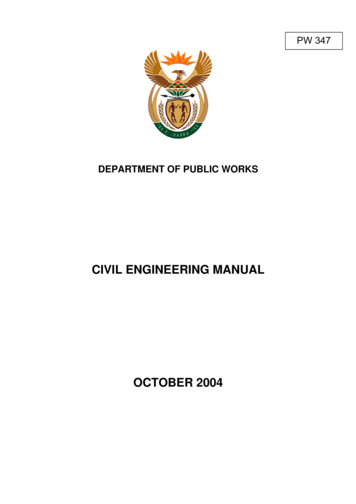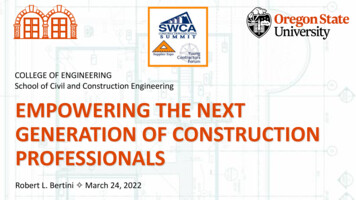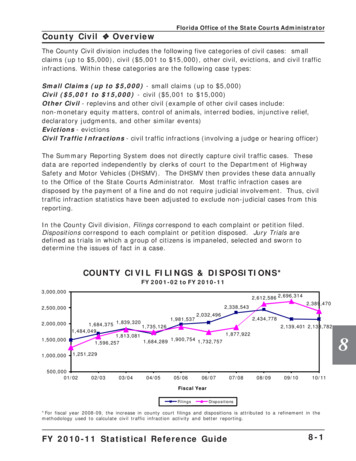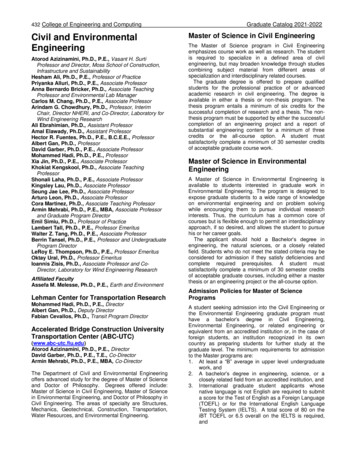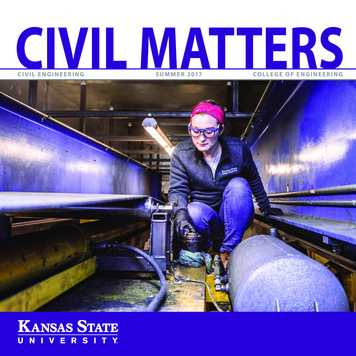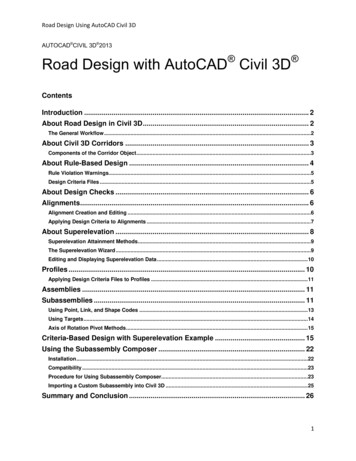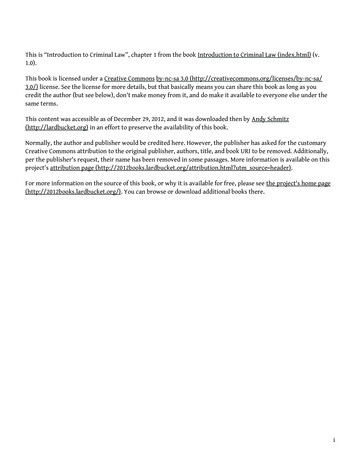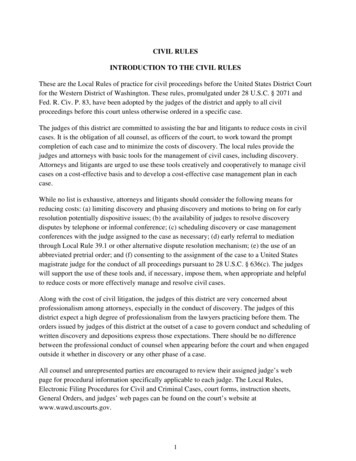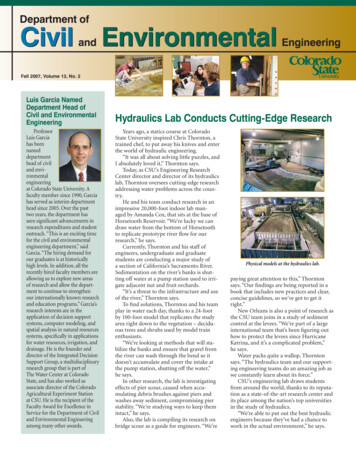
Transcription
Department ofCivilandEnvironmentalEngineeringFall 2007, Volume 13, No. 2Luis Garcia NamedDepartment Head ofCivil and EnvironmentalEngineeringHydraulics Lab Conducts Cutting-Edge ResearchProfessorLuis Garciahas beennameddepartmenthead of civiland environmentalengineeringat Colorado State University. Afaculty member since 1990, Garciahas served as interim departmenthead since 2005. Over the pasttwo years, the department hasseen significant advancements inresearch expenditures and studentoutreach. “This is an exciting timefor the civil and environmentalengineering department,” saidGarcia. “The hiring demand forour graduates is at historicallyhigh levels. In addition, all therecently hired faculty members areallowing us to explore new areasof research and allow the department to continue to strengthenour internationally known researchand education programs.” Garcia’sresearch interests are in theapplication of decision supportsystems, computer modeling, andspatial analysis in natural resourcessystems, specifically in applicationsfor water resources, irrigation, anddrainage. He is the founder anddirector of the Integrated DecisionSupport Group, a multidisciplinaryresearch group that is part ofThe Water Center at ColoradoState, and has also worked asassociate director of the ColoradoAgricultural Experiment Stationat CSU. He is the recipient of theFaculty Award for Excellence inService for the Department of Civiland Environmental Engineeringamong many other awards.Years ago, a statics course at ColoradoState University inspired Chris Thornton, atrained chef, to put away his knives and enterthe world of hydraulic engineering.“It was all about solving little puzzles, andI absolutely loved it,” Thornton says.Today, as CSU’s Engineering ResearchCenter director and director of its hydraulicslab, Thornton oversees cutting-edge researchaddressing water problems across the country.He and his team conduct research in animpressive 20,000-foot indoor lab managed by Amanda Cox, that sits at the base ofHorsetooth Reservoir. “We’re lucky we candraw water from the bottom of Horsetoothto replicate prototype river flow for ourresearch,” he says.Currently, Thornton and his staff ofengineers, undergraduate and graduatestudents are conducting a major study ofa section of California’s Sacramento River.Sedimentation on the river’s banks is shutting off water at a pump station used to irrigate adjacent nut and fruit orchards.“It’s a threat to the infrastructure and useof the river,” Thornton says.To find solutions, Thornton and his teamplay in water each day, thanks to a 24-footby 100-foot model that replicates the studyarea right down to the vegetation – deciduous trees and shrubs used by model trainenthusiasts.“We’re looking at methods that will stabilize the banks and ensure that gravel fromthe river can wash through the bend so itdoesn’t accumulate and cover the intake atthe pump station, shutting off the water,”he says.In other research, the lab is investigatingeffects of pier scour, caused when accumulating debris brushes against piers andwashes away sediment, compromising pierstability. “We’re studying ways to keep themintact,” he says.Also, the lab is compiling its research onbridge scour as a guide for engineers. “We’rePhysical models at the hydraulics lab.paying great attention to this,” Thorntonsays. “Our findings are being reported in abook that includes new practices and clear,concise guidelines, so we’ve got to get itright.”New Orleans is also a point of research asthe CSU team joins in a study of sedimentcontrol at the levees. “We’re part of a largeinternational team that’s been figuring outhow to protect the levees since HurricaneKatrina, and it’s a complicated problem,”he says.Water packs quite a wallop, Thorntonsays. “The hydraulics team and our supporting engineering teams do an amazing job aswe constantly learn about its force.”CSU’s engineering lab draws studentsfrom around the world, thanks to its reputation as a state-of-the-art research center andits place among the nation’s top universitiesin the study of hydraulics.“We’re able to put out the best hydraulicengineers because they’ve had a chance towork in the actual environment,” he says.
Alumni NewsAccolades go to Harold “Hal” Simpson,B.S. 1967, M.S. 1969 Civil, who received theGeneral Palmer Award from the AmericanCouncil of Engineering Companies ofColorado.Jay Patel, M.S. 1968 Civil, recently broughtus up-to-date. In 1973, Jay joined a smallprivate consulting engineering firm locatedin Ventura county and specializing in landdevelopment. He worked in the privatearena for over 12 years. Jay has two children,daughter, Neeta, and son, Rajan. 1975 was amemorable year for the Patels. His son, Rajan,was born in January; Jay became a naturalized citizen in May; and his parents movedfrom India along with his sister in October.In 1976 he started taking MBA classes duringthe economic downturn. He completed thecourse work in ’79, completed the dissertation in ’87, and got his MPA in ’88 fromCSUN. Jay changed jobs in ’85 moving to thepublic sector. He worked for Ventura Countyfor a short time, joined the City of Oxnardin August ’86, and then moved from the Cityof Oxnard to the City of Santa Paula in ’94.About 11 months ago, he joined the City ofAgoura Hills. Jay is currently 65 and says he isgetting close to the retirement stage. He andhis wife, Pushpa, reside in Ventura County ina small town along highway 101 between LosAngeles and Santa Barbara.James Klang, B.S. 1981 Civil, joinedKieser-Associates as a senior project scientist.James joined K&A after being lead engineerat the Minnesota Pollution Control AgencyTotal Maximum Daily Load program.Mark McLean, B.S. 1982 Civil, was namedby Deere & Ault Consultants, Inc. as a keyprofessional. Mark has 20 years of experience in civil engineering focusing on waterresources and water rights. Mark joins otherCSU civil engineering alumni at Deere & Aultincluding Daniel Ault, M.S. 1981 Civil, ColbyHayden, B.S. 1984 Civil, Michael Ballantine,B.S. 1978, M.S. 1980 Civil, and Scott Palmer,B.S. 1999 Civil.Dan Overton, B.S. 1985 Civil, was namedan ASCE Fellow. Dan is with Tetra Tech, Inc.,in Fort Collins and is past president of theASCE Northern Colorado Branch.Christopher Doherty, B.S.1991 Civil, accepted a position as a senior project managerin the area of hydrology and hydraulics withBrown & Gay Engineers in Houston.Armando Balloffet, Ph.D. 1992 Civil, reports that he continues to spend a great dealof time traveling, working for Asian Development Bank, USAID, and Millennium ChangeCorporation. He recently was at a meeting inVientiane, Laos, dealing with the proposedNam Ngiep 1 Hydropower Project and raninto Professor Thavivongse Sriburi, Ph.D.1983 Civil, director of the Environmental Research Institute of Chulalongkorn Universityin Bangkok.Robertus Triweko, Ph.D. 1992 Civil,received the decree from the Minister ofNational Education for his professorship inwater resources engineering at ParahyanganCatholic University in Indonesia.Alumnus Rami Mohmoud, second fromleft, is pictured with Tom Sheng, B.S.1973 engineering science, M.S. and Ph.D.mechanical engineering, department headLuis Garcia, and Professor Ramchand Oad.Mohamed Rami Mahmoud, M.S. 1993Civil, Ph.D. 1995, Civil, a research professorin the National Water Research Center anddirector of the Main Information Center forthe Ministry Office, Egypt, gave a presenta-tion on “Water Resources and Demand inEgypt: Future and Challenges” at CSU onOctober 8. Rami caught up on all the newswith his former professors (see photo).John Bingham, B.S. 1994, M.S. 1997 Civil,is currently with Hart Crowser in Seattle,Washington. He writes, “I continue to learnsomething new almost every day at mycurrent position at Hart Crowser. I greatlyappreciate the things I learned from you all atCSU. The practical things I learned continueto be the foundation for the diverse experiences that I’ve had.” John met Todd Cotton,B.S. 1992, M.S. 1995 Civil, at a rock mechanics short course in Seattle.Congratulations to Brenndan Torres, B.S.1995, M.S. 1997 Civil, for being named restoration project manager for Carl Walker, Inc.,in Englewood, Colorado.Thomas Chapel, M.S. 1998 Civil, waselected to ASCE’s Board of Governors for Region 7. Tom is currently employed with TetraTech, Inc., in Fort Collins, as a senior geotechnical engineer. He was a founding member ofASCE’s Northern Colorado Branch.Mark Kempton, B.S. 1999 Civil, is nowsenior engineer for Anderson ConsultingEngineers, Inc., in Fort Collins.Sunny Rose, B.S. 2002 Civil, returned tothe States in August after about five years inthe Navy. He spent most of his last year inAfghanistan working with Afghancontractors and engineers to build localinfrastructure. He isnow living in Seattleand taking time off.Sunny plans to goto graduate schoolto study transportation/construction.Sang Ngyuen, B.S. 2006 Civil, is attendingthe University of Tennessee for his master’s inenvironmental-water quality.Alumni FocusDavid Frick (B.S., 1973; M.S., 1976; Ph.D., 1990 Civil) is executive vice president of Ayres Associates, an engineering consulting firm with 16 offices in eight states. He was promoted to this position from Vice President in 2001. David has been with this company since 1972 when he was an undergraduate at Colorado State. The company startedin Fort Collins as M.W. Bittinger and Associates, Inc., which then became Resource Consultants, Inc., and mergedwith Ayres Associates in 1994. David’s expertise is in surface and groundwater hydrology and hydraulics, includingstudies related to floodplain mapping, drainage, flood control, and hydraulic design of water resource facilities. Anindividual who believes in giving back to his community, David served on the City of Fort Collins All City WaterBoard, served as president of the Fort Collins Housing Authority, and is now president of the nonprofit CARE Housing Inc., which worksto provide affordable housing for low-income families. David married Gail Richardson, B.S. 1975 Biological Science, in 1977. They havetwo children: Donald, 27, a CSU 2002 B.S. graduate in Civil Engineering; and Anna, 26, who went on to pursue a career in music. Whenasked what might be a fond memory of CSU, David said, “I thoroughly enjoyed the learning process as an undergraduate and now trulyappreciate what it was like to have the opportunity to gain knowledge without all the ‘real world responsibilities.’”
Alumni NewsAlumni News from the Peace CorpsCara Shonsey, B.S. 2005 Civil, is currently in her second year with the Peace Corps inAfrica. She reports that after a backpacking trip in April in an area called Monentali witha 1,000 vertical foot climb in 100 degrees heat, she returned to her village and Kita. Sheand her five other volunteers have put together midwife training for their villagers, as theydo not have access to health care, and a behavior change program to improve hygiene. Theyalso taught the villagers how to make soap so the women could sell it and make a profit.During the rainy season, Cara went to Bamako and taught swimming lessons to Malians, theequivalent of firemen/first responders, so they could perform rescues in the Niger River. Shethen returned to her village, where she plans to implement a project building soak pits anddistributing mosquito nets to help curb Malaria.Cara Shonsey trains a Malian onrescuing techniques.Spring Civil and Environmental GraduatesFront row (from left): Dr. Luis Garcia, Dr. Larry Roesner, Dr. Tom Sanders, Dr.Marvin Criswell, Dr. Darrell Fontane, Laurie Alburn, adviser. 2nd row: AshleyHenzel (CE), Logan Burba (CE), Kathleen Lucchesi (CE), Amanda Vance (CE),Karlie Jackl (CE), Kyle Weighaus (CE), Frank Gariglio (CE), Spencer Shram (CE),Rae Rossetti (CE), Lauren Walker (CE), Jenna Ellis (CE), Jennie Stabler (CE), Dr.Sandra Woods, Melissa Robson (CE), Erin Mick (CE), Beth White (CE), AmandaLivernash (CE), Arthur Gallagher (CE). 3rd row: Chris Muller (CE), BrendaGardner (CE), Jordan Jarrett (CE), Brian Huston (CE), Luke Harris (CE), SteveHumphrey (CE), Lindsay Merz (CE), Keith Despain (CE), Ryan Byrne (CE), AlexStone (CE), Cody Hix (CE), Carrie Lile (CE), Takao (David) Sawahata (CE). Backrow: Matt Gardella (CE), Kris Bruun (CE), Chris Turnbull-Grimes (CE), StephanieThomas (CE), William Janasak (Env), Christina Dodson (Env), Jeff Diel (CE),Steven Sapp (CE), Trevor Kirkley (CE), Tristan Bonser (CE), Carter Mast (CE), AlexNodich (CE).Alumni and Friends Websitewww.engr.colostate.edu/ce/alumni.shtmlWhat Some of Our Falland Spring GraduatesAre Doing NowRyan Byrne, B.S. 2007 Civil, has taken anEngineer I position with Martin/Martin inLakewood, Colorado.Christina Dodson, B.S. 2007 Civil, ispursuing graduate studies in environmentalengineering at Michigan State University.Rae (Rossetti) Doner, B.S. 2007 Civil, isworking with Eclipse Engineering, Inc., as anengineer-in-training for structural engineering in Montana.Art Gallagher, B.S. 2007 Civil, has taken aposition as field engineer with Hubbard Construction Company (Eurovia) in Florida.Luke Harris, B.S. 2007 Civil, is now withBishop-Brogden Associates in Englewood,Colorado, as a water resource engineer.Steven Humphrey, B.S. 2007 Civil, is aproduction engineer with TST ConsultingEngineers, Inc., in Fort Collins.Chris Muller, B.S. 2007 Civil, is now Design Engineer I for S.A. Miro Inc. in Denver,Colorado.Takao Sawahata, B.S. 2007 Civil, is aBridge Engineer 1-3 in training for the Washington State Department of Transportation.Logan Burba, B.S. 2007 Civil, is a Waterresources engineer with Leonard Rice Engineers in Denver.Carter Mast, B.S. 2007 Civil and Construction Management, is studying structuralmechanics in graduate school at the University of Washington.Look up your former classmates on the Alumni and Friends website! The news isarranged on the website according to graduation year.Send you own personal or professional news to Linda.Hinshaw@ColoState.edu
Alumni NewsSpring Alumni Award WinnersThe Department of Civil and Environmental Engineering had three honorees during the College of Engineering Spring Alumni Awards:Howard Knapp received the College of Engineering’sDistinguished Alumni Award.The Distinguished Alumni Award for the College of Engineering went toHoward Knapp, B.S. 1967 Civil, who is currently the co-president of PlumCreek Structures in Littleton, Colorado. Plum Creek is a precast, prestressconcrete company, which has been involved with many notable projectsthroughout the state of Colorado, as well as New Mexico, including theTREX I-25 widening project in Denver. The company has also been therecipient of numerous awards, including the American Concrete Institute/Rocky Mountain Chapter 2003 Award of Excellence, the 2003 OutstandingProject of the Year, and the Precast/Prestressed Concrete Institute BestRehabilitated Bridge. The latter award was for their work on the CastlewoodCanyon Bridge in Douglas County. Prior to joining Plum Creek, Howard wasemployed with Rocky Mountain Prestress and Stanley Structures. Howardis a member of Colorado State’s Former Athletes Association and the RamClub. While attending Colorado State, he was a football player and was anactive member of Chi Epsilon.Eugene “Gene” Miller, B.S. 1951 Civil, received theDepartment of Civil and Environmental Engineering’sDistinguished Alumni Award. Gene is officially retired fromthe engineering profession. He spent 45 years in geotechnicalconsulting, working on dam projects and landslide studiesand serving as the foundation engineer for many high-rise,public, industrial, and commercial structures. In addition,he has been a primary investigator for land and foundationfailures, provided consultation for remediation, and providedexpert testimony for litigation matters. During his tenurein the engineering profession, Gene founded two differentcompanies: Harding Miller Lawson and Miller PacificEngineering Group. Although “retired,” Gene has remainedactive in a number of professional engineering organizations,Eugene Miller, today, and in 1970.including the American Society of Civil Engineers, theStructural Engineers Association of Northern California,Consulting Engineers and Land Surveyors of California, and California State Board of Registration. Gene received his M.S. incivil engineering from Georgia Tech. He currently has an interest in western United States history and the construction of thetranscontinental railroad. Luis Garcia accepted the award on behalf of Eugene Miller.Brittany Albrandt, B.S. 2002 Civil Engineering and Engineering Science,received the Graduate of the Last Decade (GOLD) Award. Brittany hasbeen employed with United Launch Alliance, formally Lockheed MartinSpace Systems, since graduation. She is responsible for the integration of allstructural/mechanical interfaces between space vehicles and launch vehicles.During her tenure with Lockheed Martin, she has been active in the launchof the AV-010, Pluto New Horizons, the first spacecraft to visit Pluto. Shealso is an active recruiter of Colorado State engineering students on behalfof United Launch Alliance and Lockheed Martin. While attending ColoradoState, Brittany was actively involved with the Society of Women Engineers,Chi Epsilon, Tau Beta Pi, the American Society of Civil Engineers, andthe American Institute of Aeronautics and Astronautics. In 2006, Brittanyreceived her master’s degree in aerospace engineering from the University ofColorado at Boulder.Brittany Albrandt received theGraduate of the Last Decade (GOLD) Award.
Faculty NewsSteven Abt returns from IRAQIn May 2006, Major General StevenAbt, U.S. Army Reserve and professor ofcivil and environmental engineering, wasmobilized by the U.S. Army and deployedto Iraq to serve as part of the U.S. expeditionary force fighting the war on terrorism.MG Abt was assigned to Headquarters,Multi-National Force Iraq (MNF-I) andplaced under operational control ofthe U.S. Ambassador as the director ofoperations and deputy director of the IraqReconstruction Management Office, U.S.Embassy, Baghdad.His responsibilities encompassed theallocation and oversight of nearly 3.5billion (U.S.) used to support more than1,200 projects to build/rebuild the Iraqiinfrastructure to include electrical generation; oil production and distribution; rail,roadway, and air systems; hospitals andhealth clinics; water and waste water treatment plants; and fire, police, and postalstations. In addition, he supervised nearly100 civilian subject matter and technicalexperts in the areas of oil, electricity, waterresources, communications, health, environment and transportation. During histour, MG Abt routinely worked with Iraqidirector generals, national ministers, andsenior military leaders; the senior leadership of the U.S. Embassy and MNF-I; andvisited over 140 project sites throughoutthe country. He also served as the liaisonbetween the U.S. Embassy and the U.S.Army Corps of Engineers in theater.When asked about his year in Iraq, Abtstated, “This was the most challengingyear of my life. I positively impacted morepeople during my tour than the rest of myengineering career while living in a dangerous environment. You cannot help butcome home a different person from whenyou deployed. I hope that I may conveymany of my lessons learned on engineering in a war zone to my students.”MG Abt returned from Iraq inMay 2007 and rejoined the civil andenvironmental engineering faculty forthe Fall 2007 semester as part of histransitional retirement. He is currentlyco-teaching the senior design capstonecourse and working in the hydraulicsprogram. MG Abt was awarded the BronzeStar Medal and the Iraq Campaign Medaland is pending the Joint Meritorious UnitAward for his service. He may be contactedat sabt@engr.colostate.edu.Jorge Ramírez Returns from ZurichJorge Ramírez, professor of civil and environmental engineering, recently returned from Zurich, Switzerland, followinga yearlong sabbatical as visiting professor at the Swiss FederalInstitute of Technology (ETH), consistently ranked among thetop universities in the world.There, Ramírez collaborated with faculty, researchers,and students of the Institute of Environmental Engineeringon several research topics including soil moisture-vegetation interactions and stream eco-hydrology, bio-complexity,climate variability and change, and glacier dynamics. Ramírezalso served as an advisor for two students doing their thesisresearch; served on four M.S. graduate thesis committees; andtaught a new graduate course in hydrologic science.In addition, Ramírez gave invited lectures at scientific meetings and universities inAustria, Holland, Italy, Spain, and Switzerland.Scrap Tires Used toStabilize SoilAntonio Carraro, assistant professor of civil and environmental engineering, is spearheading an innovativeresearch project using scrap tirerubber to stabilize Colorado’s clay soil,thus reinforcing road bases and housing foundations.With a grant from the ColoradoCommission on Higher Education,funding from the Department ofTransportation, and in cooperationwith the city of Loveland, Carraro’steam of three students is seeking waysto reuse some of the nearly 40 milliontires stockpiled throughout Colorado.“Our goal is to use waste materialsto improve the technical quality oflocal soils,” he says, adding that tirerubber significantly changes the properties of expansive soil.“When it is dry, soil occupiesmuch less area,” Carraro says. “Whenwet, there is a lot of movement, whichcan cause problems with the foundation of a house.”The rubber particles replace thesoil’s volume with something lessproblematic, creating an overallmixture typically less stiff and morecompressible, he says.“We’re evaluating the effects ofcertain rubber particle sizes and theamount that must be added for anideal combination,” he says.The team also is researching methods of application, such as placinga combination of composite layersunder conventional foundations andlayering the composite with traditional pavement for road stability.“I’m excited to find ways to usesuch waste materials and make asmaller footprint on the Earth,”Carraro says.
Faculty NewsEngineering Professor at Colorado State to Evaluate StormwaterManagement in Denver, Other CitiesColorado State University’s UrbanWater Center has been awarded a contract valued at 800,000 from the WaterEnvironment Research Foundation in afirst-of-its-kind study to develop planningtools for municipalities to determine thebest way to protect urban waterways frompollution due to stormwater runoff.Municipal stormwater managementagencies in Denver, Los Angeles, Seattle,and Philadelphia have volunteered toparticipate in the study, which is intendedto provide municipalities with effectivetools for improving stormwater drainage.Stormwater can carry harmful pollutantssuch as automobile products or chemicalssuch as antibiotics used for humans andanimals into streams.The study will examine whether bestmanagement practices for stormwaterpollutant control are directly linkedto improved water quality in streams,said Larry Roesner, professor in theDepartment of Civil and EnvironmentalEngineering and director of the UrbanWater Center.“This study will provide the foundation for making better, fact-based decisions on the types of Best ManagementPractices that local governments use andapprove within their jurisdictions,” saidBen Urbonas, manager, Master PlanningProgram for the Urban Drainage andFlood Control District. The district covers1,608 square miles and includes Denver,parts of the six surrounding counties, andall or parts of 33 incorporated cities andtowns.“The issue at hand is selecting the BestManagement Practices that are most effective in protecting the receiving waters ofthe state of Colorado and are also mostcost-effective when full life-cycle costs areconsidered,” Urbonas said. “That includesnot only initial cost but also the cost ofmaintenance, eventual rehabilitation, andadministering the oversight required bythe state for cities and counties to ensurethat facilities in the ground continue tofunction for years to come.”Commonly used methods for treatingrunoff include settling and biofiltrationthat remove solids and associated pollutants from the runoff. Wetlands and createdponds are also used to remove pollutantsand nutrients that stimulate algae growthin urban waterways. Harold H. Short Civil Infrastructure Chair Larry Roesner with doctoral student Jorge Gironas.Colorado State engineers are leadersin the design of pragmatic computerizedmodels that can help cities predict theirsuccess with these runoff-control measures. The University plans to hire subcontractors, including CDM, CH2MHill, andGeosyntec to provide specialized expertiseon the study.“We’re developing tools municipalitiescan use to make better decisions aboutmanagement practices and where theyneed to put them so they can effectivelypredict impacts on water quality instreams, lakes, and other natural waterareas,” said Christine Rohrer, a researchassociate who is working on the grant withRoesner and Associate Professor BrianBledsoe.“Some metropolitan stormwater agencies have experience with state-of-the-artcontrols that are used to meet water quality standards,” Roesner said. “Denver andPhiladelphia, in particular, are leaders inthis area. However, they and most otherAmerican municipalities lack the planningtools to determine which controls workbest in a given situation, how many arerequired in a river basin, and what is thewhole-life cost to the agency for implementing these controls.”Roughly half the streams in the countryremain polluted as a result of storm runoff.Continuously flowing streams such asSpring and Fossil creeks in the Fort Collinsarea are examples of the numerous smallstreams that must meet minimum federalwater quality standards, Rohrer said.“It’s our responsibility to take careof the environment,” said Rohrer, whoobtained her doctorate in civil and environmental engineering in 2007 at CSU.“I’m glad in my job I can do that.”Roesner holds the first endowedchair in the Department of Civil andEnvironmental Engineering known as theHarold H. Short Civil Infrastructure Chair.He was elected to the National Academyof Engineering in 1990 and is a nationally recognized expert in the developmentand application of hydrologic, hydraulic,and water quality simulation models. Heserved as chief technical officer and seniorvice president at Camp Dresser and McKeeInc. before coming to Colorado State in1999. Roesner’s area of specialization since1970 has been urban hydrology and nonpoint source pollution control.Professor Roesner and doctoral studentChristine Pomeroy
Faculty NewsEmeritus Faculty NewsDavid HendricksDr. David Hendricks attended the fifthbiennial conference of the International WaterHistory Association in Tampere, Finland. Theconference was arranged by faculty at theUniversity of Tampere, including Tapio Katko,who spent his sabbatical at CSU in 1996 andhas published several books on water historyin Finland and worldwide. David chaired a session on environmental engineering educationand gave a paper, “Evolution of EnvironmentalEngineering Education in the USA.” The paperemphasized the beginning years at MIT in the 1880s through themodern period, which began in the 1960s.Dr. Katko’s discipline, as others, contains many interesting truestories interwoven with varied colorful personalities that comprise ourhistory. David comments: “Knowledge of this past helps to understandhow we have arrived at the present theory and practice of our field.All of this was a revelation to me. However, in 1968, a research projectled me to some 1880s papers. Looking at some of these papers got mehooked on history, especially when I saw that some of what was considered ‘new’ had been a part of past practice; i.e., before 1900.”This interest led him to exploring Roman ruins in various placesin the Mediterranean and becoming fascinated by past civilizations.David’s first sabbatical in 1978 in Sicily led to serendipitous discoveryof and fascination with the Greek and Roman ruins both there andthroughout Italy. His second sabbatical in 1986-87 in Istanbul wasdevoted mostly to visiting the archeological sites for which Turkey isnoted. David has tried to integrate history into teaching and writing onwater treatment. He is working on another book on water treatment,and after that, he hopes to work on a history volume.Johannes GesslerWhat has Dr. Johannes Gessler been up to? As some of you mayremember, Dr. Gessler retired in 2003 after having been associated withColorado State University for 37 years. Over that period of time, heserved the department and college in many different ways: as a facultymember, as associate department head, as interim department head,associate dean, and for a couple of years (1997-1999) as interim dean.Since then, he has taught a couple of courses (Statics and HydraulicEngineering) at times when the department was short-handed.Perhaps more importantly, he continues to serve the College ofEngineering as coordinator forstudents who are interested inthe Study Abroad Program. Hemakes presentations to freshmen students on opportunitiesrelated to Study Abroad, presents individuals with variousalternatives and helps them inthe planning process. Presently,about 5-10 percent of the graduating seniors in the CollegeDr. Gessler and his wife Seraina onof Engineering have studiedtop of the ‘Rock’ in New York City,abroad. Johannes believessummer 2007.this number is too low, partlybecause engineering has become a very internationalized professionalfield. Many of our students will work on international projects or workwith civil engineers in other countries. Consequently, he thinks that20-25 percent of our students should study abroad. Shortly before hisretirement, Johannes was instrumental in creating an InternationalEngineering option within the Engineering Science major. Students inthis option concentrate their engineeri
a section of California's Sacramento River. Sedimentation on the river's banks is shut- . In 1976 he started taking MBA classes during the economic downturn. He completed the course work in '79, completed the disserta- . 27, a CSU 2002 B.S. graduate in Civil Engineering; and Anna, 26, who went on to pursue a career in music. When

